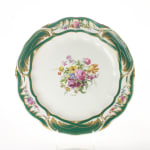Sèvres Porcelain
H.2 3/8 Dia.17 3/8 in
Further images
Literature
This is a really immense dish for the period and of a robustly-modelled form that is un-familiar except that this piece and its’ pair have been known to scholars for some years. The form is so redolent of silver made in the 1750s in Paris, that the heritage of the model is easily attributed into the work of the chief designer of shapes for the Vincennes and Sèvres factory, the silversmith Jean-Claude Chambellan Duplessis (1699-1774).
In 1761 Louis XV presented a magnificent green ground Sèvres porcelain dinner service to Jean-Joseph de Laborde (1724-94) banquier de la Cour to the King. This was an expression of gratitude to Laborde for his financing of the Seven Years War. The gift was later expanded by supplemental purchases made by Laborde over many following years.
The King’s gift delivered in July 1761 included 60 plates (costing 42 livres each) and many other shapes of pieces for serving food, sorbet and for cooling wine decanters and wine glasses. There were also 12 teacups and saucers, pairs of cheese dishes, sugar bowls and chestnut baskets.
Laborde seems to have immediately ordered more pieces to match as on 24th December 1761 the Sèvres factory’s sales registers show him purchasing a further 24 plates (perhaps soup plates, also costing 42 livres each), four large expensive covered tureens and stands, oil and vinegar decanter stands, salts and many variously sized substantial costly serving platters.
A pair of large oval dishes in the collection of the Princes of Hesse at Schloss Fasanerie in Fulda are the closest in style to the present dish with their boldly modelled scrolling rims. They are 50 cm wide, so slightly broader than this dish and its’ pair, and have the date letter H for 1760 as well as the painter’s mark for Armand jeune. The scholar David Peters considers the Hesse dishes to be the most expensive dishes in the service, costing 216 livres each. We believe that the present dish is the stand to be placed underneath one of two circular tureens which with the tureen, cover and stand cost 480 livres each – the most expensive elements of the service.
Laborde added many pieces to this dinner service with a large supplement in 1783.
Much of this service is next recorded when sold from the collections of the Princes of Torlonia in Rome at Christie’s in London on 21stMay 1886. The group by then had 42 plates, 15 soup plates and masses of the pieces from the two deliveries noted above. Into the twentieth century these pieces have been sold into many different collections. On public display, there is a compotier coquille in the Musée des Arts Décoratifs, Paris, a plate in the Duke of Wellington’s collection at Stratfield Saye, UK, and two very large oval plateaux mentioned above in the collection of the Prince of Hesse at Schloss Faisanerie, near Fulda, Germany.







